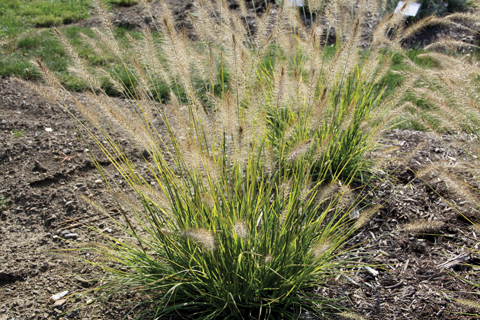12/1/2019
Growing Pennisetum Yellow Ribbons
Barry Ballard

Pennisetum alopecuroides Yellow Ribbons is a brighter, lighter version of the industry standard Hameln compact fountain grass. An added benefit: this pennisetum’s narrow (only ¼-in. wide) foliage transforms to a lovely and somewhat softer chartreuse yellow as summer ends, after spending most of the season as a golden yellow.
Its fine-textured foliage makes it a great choice for both movement and texture in the garden and in large containers, and its bold color lends it to uses for which you might not choose Hameln. Try it in a perennial bed as a backdrop, use it as a spectacular specimen or mix it among shrubs for terrific contrast. Foliage and flowers are held just slightly upright with a bit of cascade in a graceful arching form.
Pictured: Pennisetum Yellow Ribbons.
Yellow Ribbons is a great choice when the species would be too tall. Stems reach over 2-ft. long and sport pale tan, fluffy flower plumes from August to October—blooming earlier than the species for longer color, as well as more versatility for shorter growing seasons. You’ll find that birds in particular like the wheat-shaped or bottle brush-like flower heads, and the blooms last well through autumn and even hang around for winter interest before they shatter.
Yellow Ribbons grows in a lovely, compact clumping habit to about 24-in. tall, spreading almost as wide. Plants prefer full to partial sun, though too much shade may compromise flowering. This golden fountain grass isn’t overly picky about soil, with the exception of poorly drained locations—overly wet soils will hinder growth. Conversely, it tolerates drier, drought-like conditions rather well. Because it’s a warm-season grass, soil needs to warm up before you’ll see activity in spring. Yellow Ribbons is hardy in Zones 5 to 9.
Cultural tips
• Plant one plant per 1-gal. pot with the crown just at soil level. Apply a preventive fungicide drench at transplant. Plants will finish for spring sale in approximately eight to 10 weeks. You could also step up finished 1-gal. plants into a 3- or 5-gal. container in the fall for larger plants the next season.
• Choose a well-draining commercial media and keep plants on the dry side. Do not overwater. Allow plants to dry between ample waterings. Maintain soil pH at approximately 5.8 to 6.2 and soil EC (electrical conductivity) in the range of 1 to 1.5 mS/cm via 2:1 extraction method.
• Greenhouse temperatures should be between 70 and 80F (21 and 26C) during the day and 55 to 65F (12 and 18C) at night. Yellow Ribbons prefers full sun outside or at least 5,000 foot candles in the greenhouse.
• Like most pennisetums, Yellow Ribbons is a moderate feeder. Fertilize with a constant liquid feed of a balanced fertilizer with lower levels of 100 to 150 ppm nitrogen.
• Most pennisetums are generally fairly resistant to insects and diseases. Still, watch for pests and diseases, including aphids, mealybugs, spider mites, root and crown rot. Follow a monthly broad spectrum fungicide control program, as well as a standard sanitation program.
Implement an integrated preventive program that includes adequate spacing for optimum airflow to reduce the potential for foliar disease pressure and moisture buildup. Scout regularly for insects and diseases to stay ahead of pressure that’s building. Maintaining a vigilant management program should prevent most pest or disease development. GT
Barry Ballard is a plant health specialist for Emerald Coast Growers, one of the country’s largest ornamental grass and perennial liner producers.